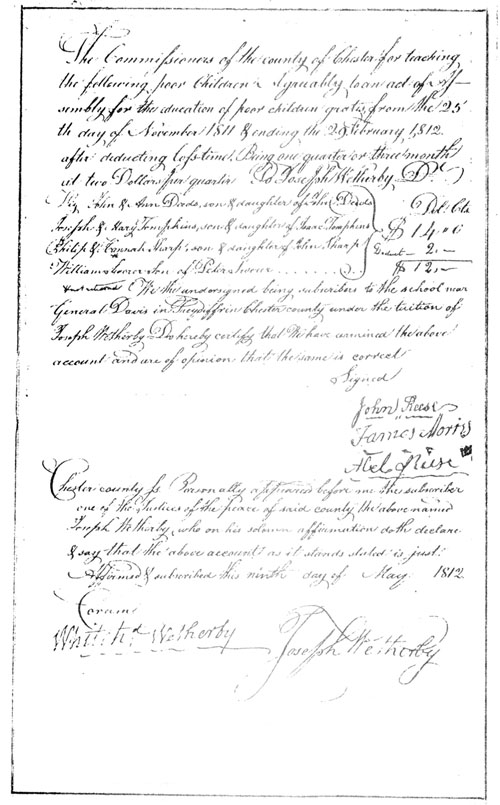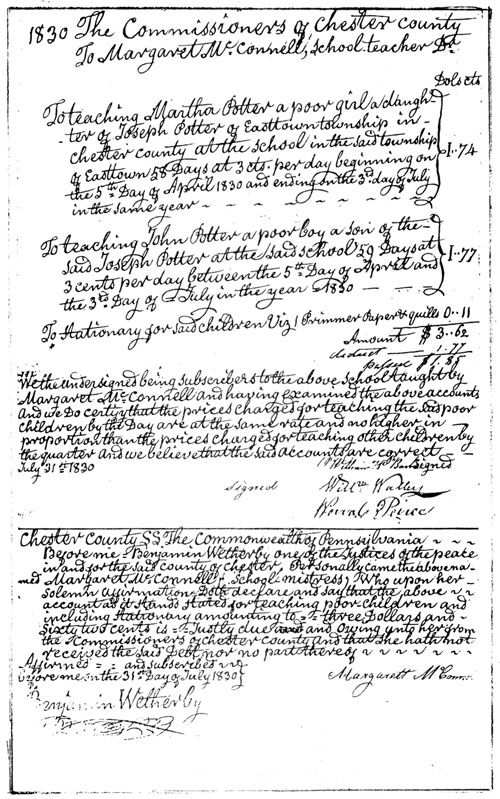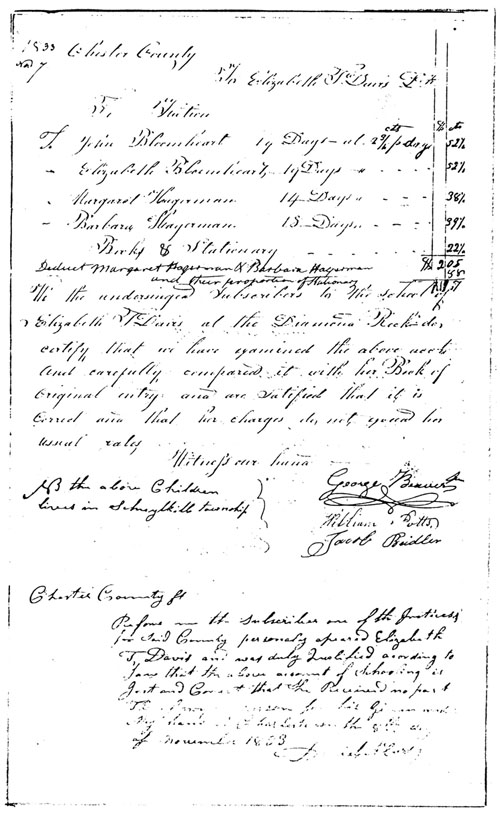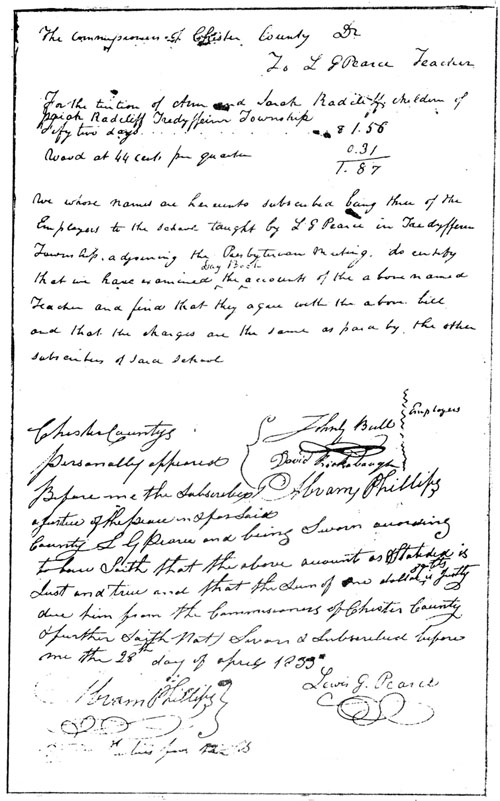|
Home : Quarterly Archives : Volume 25 |
Tredyffrin Easttown Historical Society |
|
Source: October 1987 Volume 25 Number 4, Pages 128–134 Free Schooling for the Poor During the first century and a quarter of Pennsylvania's history free public education, especially for the children of poor families, had been a desired goal, but not a reality. As early as in 1682, on "the Five and Twentieth Day of the Second Month, vulgarly called Apri11", in the ninth article of his first Frame of Government, William Penn proclaimed "That the Governor and Provincial Council shall Erect and order all publick Schools and incourage and Reward the Authors of Useful and Laudable inventions in said Province". A year later, on the 10th Day of the First Month [March], in chapter 112 of the Laws made "att the Assembly Held att Philadelphia" it was enacted that "to the End that poor as well as Rich may be instructed in good & Commendable Learning, which is to be preferred before wealth ... all persons in the Province and territories thereof having children & all Guardians or Trustees of Orphans shall cause such to be instructed in Reading & writing so that they may be able to read the Scriptures & to write by the time they attain to 12 years of age, and that then they be taught some useful trade or Skill, that the poor may work to Live & the rich, if they become poor, may not want, of which every County Court shall take Care, And in Case such parents, guardians or Overseers shall be found deficient in this respect Every parent, guardian or Overseer shall pay for every Such Child 5 pounds, except there should appear an incapacity in body or understanding to hinder it". The State Constitution adopted in 1776 went even further. In the forty-fourth section it was provided, "A school or schools shall be established in each county by the Legislature, for the convenient instruction of youth, with such salaries to the masters paid by the public as may enable them to instruct youth at low prices. And all useful learning shall be duly encouraged and promoted in one or more universities." When a Constitutional Convention met in 1789 to revise this Constitution of 1776, the original draft of the article on education was quite similar to the provisions of the earlier one. In this draft Section I of Article VII, it provided that "A school or schools shall be established in each county for the instruction of youth, and the state shall pay to the masters such salaries as shall enable them to teach at a low price", while in Section II it was provided, "The Arts and Sciences shall be promoted in one or more Seminaries of learning." Before final adoption, however, Section I was amended to read, "The Legislature shall, as soon as conveniently maybe, provide by law for the establishment of schools throughout the state, in such a manner that the poor may be taught gratis." Despite these repeated constitutional mandates, little or nothing was done by the Legislature to implement them or to establish schools "in each county" or "throughout the state". The schools of the 18th century and early 19th century were either denominational schools affiliated with one of the churches or "neighborhood" schools established and operated by the voluntary cooperative action of a group of people in a neighborhood. (Although there was a tuition fee to attend, these schools were sometimes referred to as "free" schools in that they were free of any religious affiliation.) Acts to implement the provisions of the 1790 Constitution and "to provide for the more effectual education of the children of the poor gratis" were passed in 1802 and 1804, but, despite their title, they were not effective. Finally, in 1809 a "more carefully drawn" Act of the same title was passed by the Legislature. Under its provisions it became the duty of the County Commissioners "to receive from the parents the names of all the children between the ages of five and twelve years . . . whose parents are unable to pay for their schooling". The assessor was then "to inform the parents that they were at liberty to send them [their children] to the most convenient school, free of expense" and also to send "the names of the children, aforesaid, to the teachers of schools within the township, ward or district, whose duty it shall be to teach all such children as may come to their schools, in the same manner as other children are taught". The teachers, in turn, were periodically to submit to the County Commissioners, from a day-book they were to keep, a verified account of the instruction given to these children and also for the stationery and other supplies provided, for approval by the County Commissioners and reimbursement by the county treasurer "out of any moneys in the treasury". While the Act did not provide "for the establishment of schools" and was widely criticized because it compelled parents to make a public record of their poverty, it nonetheless succeeded in making, at long last, free education for the children of the poor in Pennsylvania a reality. A number of the accounts submitted by teachers under the Act are in the collections of the Chester County Historical Society. A few of them, pertaining to schools in Tredyffrin or Easttown township, are reproduced (in reduced size) on the following pages.
The "schoolhouse near General Davis", in Howellville, was probably the first neighborhood" school in either township, established perhaps as early as in the 1730s on land leased from General Davis for 999 years at an annual rent of one peppercorn. It and the other early neighborhood schools later became a part of the public school system.
Andrew Garden, a fifer during the Revolutionary War, taught at the old Eagle School for many years. The school was started by the Lutherans in what is now Strafford in about 1785, but within a few years became a neighborhood school. Note the charge for firewood as well as for books, slates, stationery, quills, ink, and, of course, tuition.
The first Glassley School was built in 1808 in the planned village of the same name, laid out along the Lancaster Turnpike [Old Lancaster Road] between what are now Devon and Berwyn. After the first Glassley School burned down, a new school was built nearby and used as a school until 1888, when it was replaced by a larger school in Berwyn.
The Diamond Rock School., on Yellow Springs road, is well known throughout the area. The octagonal school was built as a neighborhood school in 1818, at a cost of $260.93. Although the school is in Tredyffrin, these pupils lived in Schuylkill Township; the crossing of township lines to go to school was not unusual at that time.
The Presbyterian School, on Swedesford road in Tredyffrin, took its name from its proximity to the Great Valley Presbyterian Church. It was later known as School No. 3 in the Tredyffrin school system, and was used until 1926. The former schoolhouse is still standing and has been converted into a private residence. |




